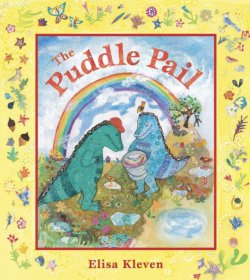Gareth B. Matthews

Review of The Puddle Pail by Elisa Klevin (New York: Puffin Books, 1997). Originally published in Thinking: The Journal of Philosophy for Children 15(4): 1.
Ernst, a young blue crocodile, and Sol, his big green brother, set off together for the beach. Sol, who loves to collect things, announces that he will fill his pail with shells. As it turns out, Sol already has a rock collection, a feather collection, and a collection of rubber bands. Ernst is uncertain. “I don’t know what to collect,” he admits.
“Collect something that comes in different sizes and colors and shapes,” suggests Sol.
Ernst watches the clouds in the sky make different shapes. “I wish I could collect clouds,” he says.
“You can’t collect clouds!” exclaims Sol. “Think of something else.”
Ernst thinks he might collect stars. Sol tells him he can’t do that and proposes that he collect starfish instead. But Ernst says he would rather leave the starfish in the ocean. Sol suggests that Ernst collect bottle caps. But Ernst decides on puddles instead.
“You can’t collect puddles,” insists Sol. But Ernst has already started scooping up the water from puddles and putting it in his pail. Sol rolls his eyes.
After a time at the beach the brothers return home. Ernst puts his puddle pail down on the grass, where it reflects the clouds moving across the sky. When Ernst gets up the next day, he finds a dog drinking water from the puddle pail. Ernst uses the remaining water to make watercolor pictures, which he then collects and shows to Sol.
“Let’s go collect blackberries,” says Ernst, who hadn’t had any breakfast.
“Maybe we’ll find some pennies and pinecones and gum wrappers,” suggests Sol, thinking about the possibilities for new collections.
“And maybe some shadows,” says Ernst. “You can’t collect shadows,” says Sol. So Ernst and Sol fill their pail with blackberries.
The Puddle Pail is an invitation to think about the metaphysics of collectibles – and perhaps their axiology, too. (An axiology is a theory of value.) Sol wants to collect shells. He already has collections of rocks, feathers, and rubber bands. Sol collects things that are at least moderately durable. They are also things that come in different sizes and shapes and can be put together with other items of their kind in a box or a bucket without danger that the individual items will melt or run together with other items. No doubt the reason that Sol insists one can’t collect puddles or shadows is that they are not durable objects. They tend to run together, or to evaporate or disappear.
The idea of making a collection of things is usually bound up with the possibility of selling or exchanging them – comparing them with each other and with items in other collections, and admiring, perhaps even displaying them. Neither puddles nor shadows have the durability needed for such manipulation and assessment.
Why do we collect things anyway? Sometimes we treasure one or more of the individual items that make up our collections. Sol might well have been very fond of some of his shells or rocks or feathers. But the axiology of collections seems to support this principle: A good collection is more valuable than the sum of the values of the individual items that make it up.
What makes this principle of axiology hold? Sol advises his brother to collect things that come in different sizes and colors and shapes. The suggestion is that having, say, rocks that differ in these ways adds interest and value to whatever value or interest the rocks might have individually.
Not every child, and not every adult, is a collector. But collecting things is certainly a natural human activity. The practice of collecting things can certainly be studied for the psychological, social, economic, or anthropological importance of the phenomenon. It can also be studied philosophically, perhaps in an effort to develop a plausible metaphysics and axiology of collectibles.
Peter Strawson distinguishes between descriptive and revisionary metaphysics. Sol, we could say, is a descriptive metaphysician. He tells us how we usually think about what kind of thing can be collected. He also tells us a little bit about our implicit axiology of collectibles. Ernst, by contrast, seems to be a revisionist. Even if we are not won over to his revisions, his thoughts and interests ought to make us all reflect a bit on what we think is collectible, and why we make collections.
It might be fun to collect the opinions of the children around you about Sol, Ernst, and The Puddle Pail. It might also be fun to reflect on those opinions. The opinions, I predict, will come in many different sizes, shapes, and colors. What fun!
